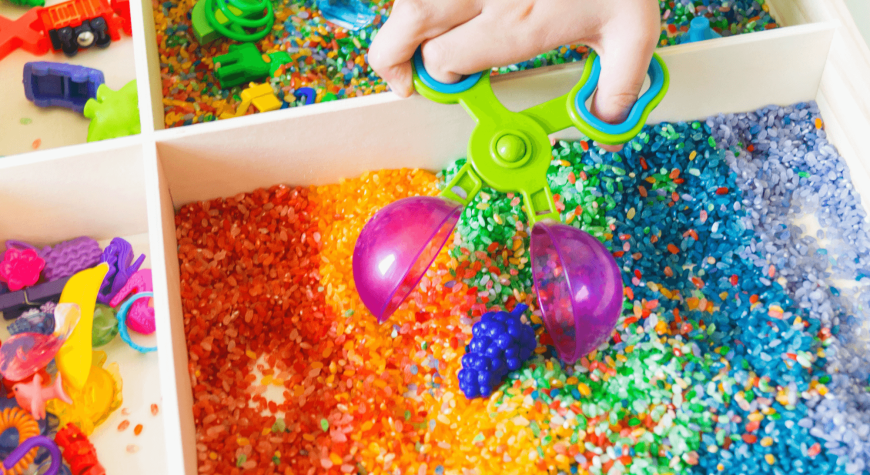Ever notice how some kids seem to be more sensitive to certain textures, sounds, or lights? Or maybe your child craves certain sensory experiences, like spinning or touching everything in sight? These are just a few examples of how sensory processing can manifest in children. Whether your child has sensory processing challenges or you’re simply looking to engage their senses in a positive way, incorporating sensory activities at home can be beneficial.
In this article, we’ll explore various sensory processing activities that you can easily do at home with your child. Not only are these activities fun, but they can also be incredibly beneficial for your child’s development. So, let’s dive in and discover how you can make your home a sensory wonderland!
Understanding Sensory Processing

Sensory processing refers to how our brains interpret and respond to the sensory information we receive from the world around us. This includes what we see, hear, touch, taste, and smell, as well as how we perceive movement and body position.
For most of us, sensory processing happens automatically without much thought. But for some children, processing sensory information can be overwhelming or challenging. This is where sensory activities come in handy. By engaging your child in sensory play, you can help them better understand and respond to the sensory input they encounter daily.
Creating a Sensory-Friendly Environment at Home
The first step in incorporating sensory processing activities at home is to create a sensory-friendly environment. You don’t need to transform your entire home, but having a designated space where your child feels comfortable and can explore their senses is a great start. Let’s call it the sensory corner.
A sensory corner is a small, designated space where your child can engage in sensory play. It can be as simple as a corner of the living room with a soft mat, some pillows, and a few sensory toys. Add in items like fidget toys, stress balls, or a weighted blanket to help your child feel calm and focused.
You don’t need fancy equipment to create a sensory-rich environment. Everyday items like rice, beans, water, and sand can provide endless sensory experiences. Fill a plastic bin with rice or beans and let your child explore with their hands, or create a water play station with different cups, spoons, and sponges.
Sensory Processing Activities for Home
Now that you’ve got your sensory corner set up, let’s get into some specific activities that will engage your child’s senses and help them develop important skills.
1. Tactile Activities
Tactile activities involve the sense of touch and are great for kids who are either sensitive to textures or crave different tactile experiences.
- Sensory Bins: Sensory bins are a classic and versatile way to engage your child’s tactile sense. Fill a bin with materials like rice, pasta, or kinetic sand, and add small toys or objects for your child to find. This activity encourages exploration, fine motor skills, and creativity.
- Playdough Creations: Playdough is another fantastic tactile activity. You can make your own playdough at home using flour, salt, water, and food coloring. Let your child mold, squish, and create whatever their imagination dreams up. The act of manipulating the playdough can be very soothing and helps improve hand strength and coordination.
2. roprioceptive Activities
Proprioceptive activities are all about understanding body position and movement. These activities can be particularly helpful for kids who need to improve their body awareness or have a lot of energy to burn.
- Animal Walks: Animal walks are a fun way to get your child moving and engage their proprioceptive sense. Have them crawl like a bear, hop like a frog, or slither like a snake across the room. Not only does this get them moving, but it also helps with motor planning and coordination.
- Pillow Pile: Create a pile of pillows on the floor and let your child jump into them, crawl over them, or push them around. The resistance from the pillows provides proprioceptive input and can help your child feel grounded and calm.
3. Vestibular Activities
The vestibular system is responsible for our sense of balance and movement. Vestibular activities are great for kids who love to spin, swing, or move quickly, as well as those who need to improve their balance.
- Swinging: If you have space, consider setting up an indoor swing. Swinging provides a lot of vestibular input and can be both calming and stimulating, depending on your child’s needs. You can also head to the local playground for some outdoor swinging fun.
- Rolling Down a Hill: Find a grassy hill and let your child roll down it. This simple activity provides plenty of vestibular input and is a ton of fun! If a hill isn’t available, you can mimic the sensation by rolling your child up in a blanket and gently unrolling them on the floor.
4. Auditory Activities
Auditory activities focus on hearing and can help children who are sensitive to sounds or those who seek out auditory input.
- Sound Matching Games: Create a sound-matching game using small containers filled with different objects like rice, beans, or coins. Have your child shake the containers and try to match the sounds. This activity helps develop auditory discrimination and attention to detail.
- Musical Instruments: Encourage your child to explore different musical instruments, like drums, tambourines, or shakers. You can even make your own instruments at home using household items. Playing music and singing along can be a joyful way to engage your child’s auditory sense.
5. Visual Activities
Visual activities stimulate the sense of sight and are perfect for children who enjoy bright colours, patterns, and visual challenges.
- I-Spy Games: Play I-Spy around the house or in your sensory corner. Choose objects of different colours, shapes, or sizes for your child to find. This activity sharpens visual perception and attention to detail.
- Light-Up Toys: Introduce light-up toys or use a flashlight to create different patterns and shapes on the walls. You can also use a light table, if you have one, to explore different colors and transparencies. These activities are visually stimulating and can help with focus and concentration.
Benefits of Sensory Processing Activities
Incorporating sensory processing activities into your daily routine isn’t just about keeping your child entertained—there are plenty of developmental benefits as well.
Enhancing Motor Skills
Many sensory activities, like playing with playdough or navigating a sensory bin, help improve fine motor skills and hand-eye coordination. These activities require your child to use their hands in different ways, which strengthens the muscles and improves dexterity.
Supporting Emotional Regulation
Children who struggle with sensory processing often have difficulty regulating their emotions. Sensory activities can provide the input they need to feel calm and centered. For example, swinging or deep pressure activities like the pillow pile can help reduce anxiety and improve mood.
Promoting Cognitive Development
Sensory play encourages problem-solving, creativity, and exploration. By engaging in activities that stimulate their senses, children can learn about cause and effect, develop critical thinking skills, and explore new concepts in a hands-on way.
Making Sensory Play a Part of Your Routine
Engaging in sensory processing activities at home is a wonderful way to support your child’s development and help them navigate the world with confidence. From tactile and proprioceptive activities to auditory and visual stimulation, there’s no shortage of ways to make sensory play a regular part of your routine.
Remember, the key is to create a safe and supportive environment where your child can explore their senses at their own pace. With a little creativity and a lot of love, you can turn everyday moments into valuable sensory experiences that will benefit your child for years to come. Whether you’re exploring sensory processing activities or seeking more structured support like occupational therapy for your child, the goal should be about finding what works best for your child and watching them thrive.


One Comment
betgorillas
December 5, 2025 @ 10:33 pmRight, time to check out betgorillas. Hoping for some good wins! The site looks pretty good, and the bonuses are tempting. Let’s see what happens! More details here: betgorillas